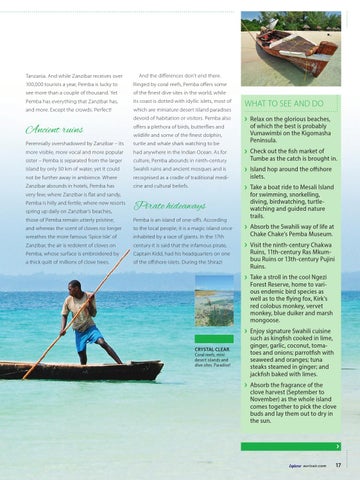Tanzania. And while Zanzibar receives over
And the differences don’t end there.
100,000 tourists a year, Pemba is lucky to
Ringed by coral reefs, Pemba offers some
see more than a couple of thousand. Yet
of the finest dive sites in the world, while
Pemba has everything that Zanzibar has,
its coast is dotted with idyllic islets, most of
and more. Except the crowds. Perfect!
which are miniature desert island paradises devoid of habitation or visitors. Pemba also
Ancient ruins
offers a plethora of birds, butterflies and
Perennially overshadowed by Zanzibar – its
turtle and whale shark watching to be
more visible, more vocal and more popular
had anywhere in the Indian Ocean. As for
sister – Pemba is separated from the larger
culture, Pemba abounds in ninth-century
island by only 50 km of water; yet it could
Swahili ruins and ancient mosques and is
not be further away in ambience. Where
recognised as a cradle of traditional medi-
Zanzibar abounds in hotels, Pemba has
cine and cultural beliefs.
wildlife and some of the finest dolphin,
› Relax on the glorious beaches,
of which the best is probably Vumawimbi on the Kigomasha Peninsula.
› Check out the fish market of
Tumbe as the catch is brought in.
› Island hop around the offshore
islets.
› Take a boat ride to Mesali Island
very few; where Zanzibar is flat and sandy, spring up daily on Zanzibar’s beaches,
Pirate hideaways
those of Pemba remain utterly pristine;
Pemba is an island of one-offs. According
and whereas the scent of cloves no longer
to the local people, it is a magic island once
wreathes the more famous ‘Spice Isle’ of
inhabited by a race of giants. In the 17th
Zanzibar, the air is redolent of cloves on
century it is said that the infamous pirate,
Pemba, whose surface is embroidered by
Captain Kidd, had his headquarters on one
a thick quilt of millions of clove trees.
of the offshore islets. During the Shirazi
Pemba is hilly and fertile; where new resorts
WHAT TO SEE AND DO
for swimming, snorkelling, diving, birdwatching, turtlewatching and guided nature trails.
› Absorb the Swahili way of life at
Chake Chake’s Pemba Museum.
› Visit the ninth-century Chakwa
Ruins, 11th-century Ras Mkumbuu Ruins or 13th-century Pujini Ruins.
› Take a stroll in the cool Ngezi
Forest Reserve, home to various endemic bird species as well as to the flying fox, Kirk’s red colobus monkey, vervet monkey, blue duiker and marsh mongoose.
› Enjoy signature Swahili cuisine CRYSTAL CLEAR
Coral reefs, mini desert islands and dive sites. Paradise!
such as kingfish cooked in lime, ginger, garlic, coconut, tomatoes and onions; parrotfish with seaweed and oranges; tuna steaks steamed in ginger; and jackfish baked with limes.
› Absorb the fragrance of the
clove harvest (September to November) as the whole island comes together to pick the clove buds and lay them out to dry in the sun.
›
auricair.com
17
